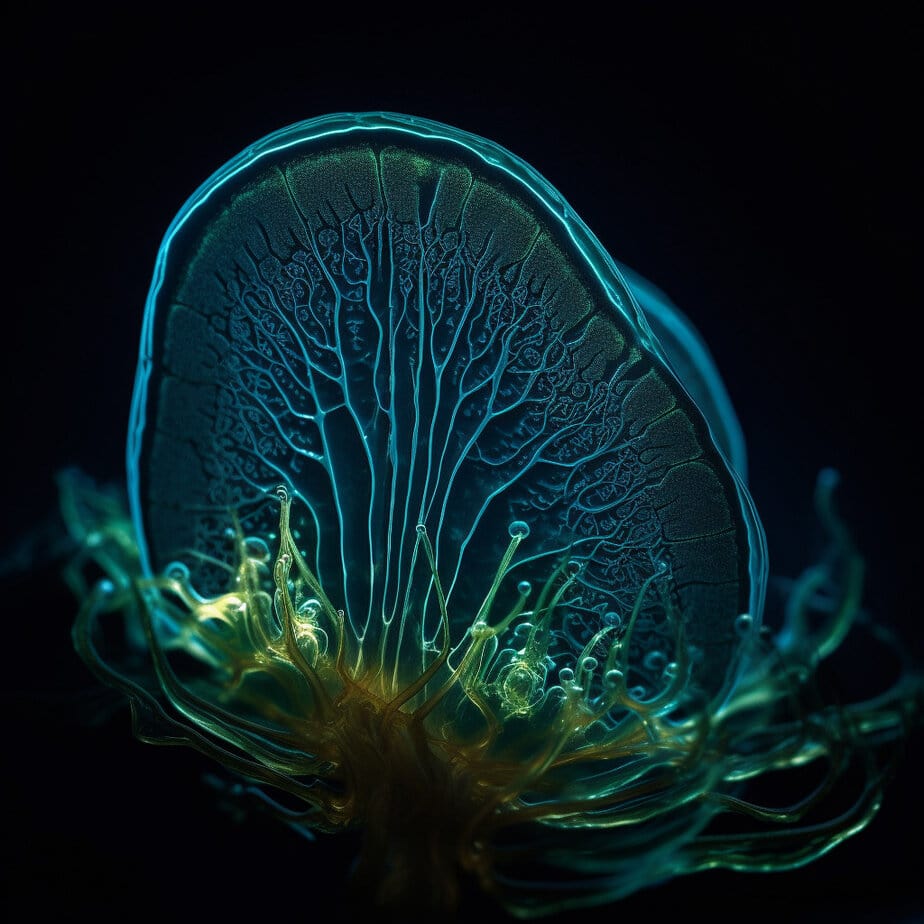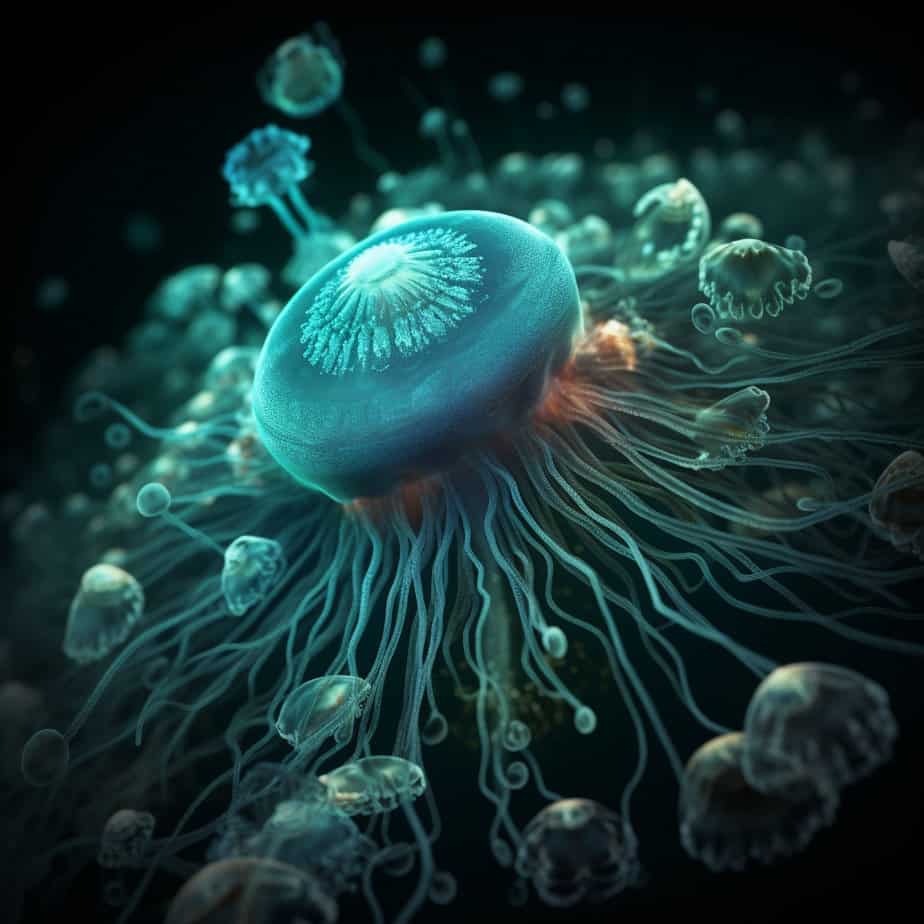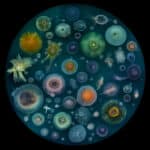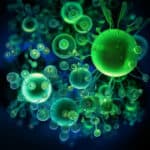Dinoflagellates are a group of single-celled organisms that belong to the phytoplankton community. Phytoplankton are microscopic plants that float in the ocean and other bodies of water, playing a crucial role in the marine ecosystem. These tiny organisms are responsible for producing a significant portion of the Earth’s oxygen and form the base of the marine food chain. Dinoflagellates, with their diverse shapes and sizes, are an essential component of this diverse group of organisms. They are characterized by their ability to photosynthesize, using sunlight to convert carbon dioxide and nutrients into energy. Dinoflagellates are found in both freshwater and marine environments, and their presence can often be detected by the distinctive colors they impart to the water, such as the phenomenon known as “red tide.” In this article, we will explore the fascinating world of dinoflagellates and their role as phytoplankton in marine ecosystems.
Key Takeaways
- Dinoflagellates are a type of phytoplankton.
- They are single-celled organisms that are capable of photosynthesis.
- Dinoflagellates play a crucial role in marine ecosystems as primary producers.
- Some dinoflagellates can produce harmful algal blooms, which can have negative impacts on marine life and human health.
- Understanding the biology and ecology of dinoflagellates is important for studying and managing marine environments.
Understanding Dinoflagellates: An Overview

A. Definition of Dinoflagellates
Dinoflagellates are a diverse group of single-celled organisms that belong to the phylum Dinoflagellata. These microscopic organisms are found in both freshwater and marine environments, playing a crucial role in the Earth’s ecosystems. Dinoflagellates are unique in that they possess two flagella, whip-like structures that enable them to move through the water.
Dinoflagellates can be further classified into two main categories based on their mode of nutrition: autotrophic and heterotrophic. Autotrophic dinoflagellates are photosynthetic, meaning they can produce their own food using sunlight, just like plants. Heterotrophic dinoflagellates, on the other hand, obtain their nutrients by consuming other organisms or organic matter.
B. Where Dinoflagellates Live and Thrive
Dinoflagellates are found in a wide range of aquatic habitats, including oceans, lakes, rivers, and even brackish estuaries. They are particularly abundant in marine environments, where they form an essential component of the phytoplankton community. Phytoplankton refers to the microscopic plants that drift near the surface of the water, serving as the primary producers in the marine food chain.
In the ocean, dinoflagellates can be found in both warm and cold waters, from tropical regions to polar seas. They thrive in areas with ample sunlight, as their photosynthetic capabilities rely on harnessing the energy from the sun. Additionally, dinoflagellates can tolerate a wide range of salinity levels, allowing them to adapt to various marine ecosystems.
Dinoflagellates are known for their ability to form massive blooms, which can be visible to the naked eye. These blooms occur when environmental conditions, such as nutrient availability and water temperature, are favorable for their growth. While some dinoflagellate blooms are harmless, others can have detrimental effects on marine life and human health. Certain species of dinoflagellates produce toxins that can cause harmful algal blooms, commonly known as red tides.
Overall, dinoflagellates play a crucial role in the marine ecosystem. They are not only important primary producers but also serve as a vital food source for other organisms, such as zooplankton. Understanding the characteristics and ecological significance of dinoflagellates is essential for comprehending the intricate dynamics of our oceans and the delicate balance of life within them.
Dinoflagellates and Phytoplankton: The Connection
A. Are Dinoflagellates Phytoplankton?
Dinoflagellates are indeed a type of phytoplankton. Phytoplankton refers to the microscopic, photosynthetic organisms that drift in the ocean and other bodies of water. These organisms are crucial to the health and balance of marine ecosystems, as they form the foundation of the food chain and play a significant role in the global carbon cycle.
Dinoflagellates are a diverse group of single-celled organisms that belong to the kingdom Protista. They are characterized by their unique shape, possessing two flagella that allow them to move through the water. Some dinoflagellates are photosynthetic, meaning they can produce their own food through photosynthesis, while others are heterotrophic, relying on organic matter for nutrition.
B. The Role of Dinoflagellates in the Phytoplankton Community
Dinoflagellates play a vital role in the phytoplankton community. They are one of the major groups of phytoplankton, alongside diatoms and cyanobacteria. These microscopic organisms are responsible for approximately half of the primary production in the world’s oceans, converting sunlight, carbon dioxide, and nutrients into organic matter through photosynthesis.
One of the unique characteristics of dinoflagellates is their ability to form blooms. Under certain conditions, such as warm water temperatures and high nutrient levels, dinoflagellates can multiply rapidly, leading to a phenomenon known as a “red tide.” These blooms can have significant ecological and economic impacts, as they can produce toxins that harm marine life and affect human health.
Apart from their ecological importance, dinoflagellates also contribute to the beauty of the ocean. Some species of dinoflagellates are bioluminescent, meaning they emit light when disturbed. This bioluminescence creates a mesmerizing display of glowing waves and sparkling water, often observed at night or in areas with high concentrations of these organisms.
In addition to their role in the marine ecosystem, dinoflagellates also interact with other organisms. They can form symbiotic relationships with corals, providing them with essential nutrients through photosynthesis. Dinoflagellates are also a crucial food source for zooplankton, which are small animals that feed on phytoplankton. This relationship forms the basis of the marine food chain, as zooplankton are then consumed by larger organisms, ultimately supporting the entire oceanic ecosystem.
In conclusion, dinoflagellates are a type of phytoplankton that play a significant role in marine ecosystems. Their ability to photosynthesize and form blooms, along with their interactions with other organisms, makes them essential for the health and balance of the ocean. Understanding the connection between dinoflagellates and phytoplankton is crucial for comprehending the intricate dynamics of marine environments and the impact they have on our planet.
Dinoflagellates vs. Diatoms: Key Differences

A. Structural Differences Between Dinoflagellates and Diatoms
When it comes to phytoplankton, two common types that often come up in discussions are dinoflagellates and diatoms. While both belong to the kingdom Protista and play crucial roles in marine ecosystems, they have distinct characteristics that set them apart.
Dinoflagellates:
Dinoflagellates are single-celled organisms that possess a unique structure. They have two flagella, whip-like appendages that enable them to move through the water. One flagellum wraps around the organism’s body in a groove, while the other extends outward. This flagellar arrangement allows dinoflagellates to spin as they move, giving them a distinctive spinning motion.
Additionally, dinoflagellates have a cellulose-based cell wall, which provides them with support and protection. Some species of dinoflagellates also possess an outer covering called a theca, which further reinforces their structure. The theca can be composed of plates, which fit together like a suit of armor, or it can be flexible and leathery.
Diatoms:
In contrast, diatoms are also single-celled organisms but have a different structural composition. Diatoms are enclosed within a unique cell wall made of silica, a glass-like substance. This intricate cell wall, known as a frustule, consists of two overlapping halves, resembling a petri dish or a pillbox. The frustule provides diatoms with protection and support.
Diatoms come in a wide range of shapes and sizes, with some forming intricate patterns or delicate filaments. Their frustules are often elaborately sculpted, displaying intricate designs and patterns. This diversity in shape and structure allows diatoms to occupy various ecological niches in aquatic environments.
B. Functional Differences: How Dinoflagellates and Diatoms Feed
Apart from their structural differences, dinoflagellates and diatoms also have distinct feeding mechanisms.
Dinoflagellates:
Dinoflagellates can be both autotrophic and heterotrophic, meaning they can produce their own food through photosynthesis or consume other organisms for nutrition. Photosynthetic dinoflagellates contain chloroplasts, allowing them to convert sunlight into energy. These organisms play a vital role in the marine food web as primary producers, providing food for other organisms.
Some dinoflagellates are also mixotrophic, meaning they can switch between autotrophic and heterotrophic modes of nutrition depending on environmental conditions. This flexibility allows them to survive in nutrient-poor waters by supplementing their diet with organic matter or by engulfing smaller organisms.
Diatoms:
Diatoms, on the other hand, are primarily photosynthetic organisms. They rely on photosynthesis to convert sunlight into energy and are considered one of the most efficient primary producers in the ocean. Diatoms have a unique adaptation that enables them to thrive in nutrient-rich and nutrient-poor waters. They possess a pigment called fucoxanthin, which gives them a golden-brown color and allows them to absorb light efficiently.
Diatoms use their frustules to regulate the amount of light they receive. They can adjust their position within the water column, moving closer to the surface to capture more light or sinking deeper to avoid excessive light exposure. This ability to control their position in the water column allows diatoms to optimize their photosynthetic activity.
In conclusion, while both dinoflagellates and diatoms are phytoplankton and contribute significantly to marine ecosystems, they differ in their structural characteristics and feeding mechanisms. Understanding these differences is essential for comprehending the intricate dynamics of the oceanic food web and the role of these organisms in maintaining a healthy marine environment.
Dinoflagellates and Zooplankton: A Complex Relationship
A. Are Dinoflagellates Zooplankton?
When discussing the intricate web of life in the ocean, it is important to understand the distinction between different types of organisms. Zooplankton, as the name suggests, refers to the animal-like organisms that drift along with the currents in the ocean. These tiny creatures play a crucial role in the marine ecosystem as they serve as a vital food source for many larger marine animals.
Dinoflagellates, on the other hand, are a diverse group of single-celled organisms that can be found in both freshwater and marine environments. They are characterized by their unique flagella, which enable them to move through the water. While some dinoflagellates are photosynthetic and therefore classified as phytoplankton, others are heterotrophic and behave more like zooplankton.
So, are dinoflagellates zooplankton? The answer is not as straightforward as one might think. While some dinoflagellates are indeed zooplankton due to their feeding habits, many others are considered phytoplankton because they possess chloroplasts and can carry out photosynthesis. This dual nature of dinoflagellates makes them a fascinating group of organisms that blur the line between plant and animal.
B. Dinoflagellates: Phytoplankton or Zooplankton?
Dinoflagellates exhibit a wide range of characteristics, making it challenging to categorize them definitively as either phytoplankton or zooplankton. Let’s delve deeper into their characteristics to better understand their classification.
-
Photosynthetic Dinoflagellates: Many dinoflagellates are photosynthetic and possess chloroplasts, allowing them to convert sunlight into energy through photosynthesis. These dinoflagellates are considered phytoplankton and play a crucial role in the marine food chain by producing organic matter that supports other marine organisms.
-
Heterotrophic Dinoflagellates: In contrast to photosynthetic dinoflagellates, some species are unable to carry out photosynthesis and rely on consuming other organisms for their energy needs. These heterotrophic dinoflagellates behave more like zooplankton and are classified as such due to their feeding habits.
-
Bioluminescent Phytoplankton: One fascinating characteristic of some dinoflagellates is their ability to produce light, a phenomenon known as bioluminescence. This light production serves various purposes, including defense mechanisms and attracting prey. Bioluminescent dinoflagellates are considered phytoplankton due to their photosynthetic capabilities.
-
Dinoflagellate Blooms and Red Tides: Dinoflagellates are known for their ability to form massive blooms under certain conditions. These blooms can have significant ecological impacts, both positive and negative. Some dinoflagellate blooms can lead to the formation of “red tides,” which are harmful algal blooms that can produce toxins harmful to marine life and humans.
In conclusion, dinoflagellates are a diverse group of organisms that exhibit characteristics of both phytoplankton and zooplankton. While some dinoflagellates are photosynthetic and classified as phytoplankton, others behave more like zooplankton due to their feeding habits. This complex relationship between dinoflagellates and zooplankton highlights the intricate nature of the marine ecosystem and the interconnectedness of its inhabitants.
The Life Cycle of Dinoflagellates: Reproduction and Survival

Dinoflagellates are a diverse group of single-celled organisms that belong to the phytoplankton community. These microscopic organisms play a crucial role in marine ecosystems as primary producers, contributing to the overall productivity of the oceans. Understanding the life cycle of dinoflagellates is essential in comprehending their reproduction and survival strategies.
A. How Dinoflagellates Reproduce
Dinoflagellates employ various reproductive strategies to ensure their survival and population growth. The two primary methods of reproduction in dinoflagellates are asexual and sexual reproduction.
-
Asexual Reproduction: Asexual reproduction is the most common method employed by dinoflagellates. It involves the division of a single cell into two daughter cells through a process called binary fission. During binary fission, the cell duplicates its genetic material and divides into two identical daughter cells. This rapid and efficient method allows dinoflagellates to reproduce and multiply quickly under favorable conditions.
-
Sexual Reproduction: Sexual reproduction in dinoflagellates involves the fusion of two gametes, or reproductive cells, to form a zygote. This process occurs when environmental conditions become unfavorable, such as nutrient depletion or changes in temperature. Dinoflagellates can produce both male and female gametes, and the fusion of these gametes leads to the formation of a zygote. The zygote undergoes a period of dormancy, forming a resting cyst, which allows the dinoflagellate to survive harsh conditions until favorable conditions return. Once conditions improve, the cyst germinates, and the dinoflagellate resumes its normal life cycle.
B. Factors Influencing Dinoflagellate Reproduction
Several factors influence the reproductive patterns of dinoflagellates. These factors can either promote or inhibit their reproduction, ultimately shaping their population dynamics in marine ecosystems.
-
Nutrient Availability: Nutrient availability, particularly nitrogen and phosphorus, plays a crucial role in dinoflagellate reproduction. These elements are essential for the synthesis of proteins and nucleic acids, which are vital for cell division and growth. When nutrient concentrations are high, dinoflagellates can rapidly reproduce and form dense populations known as blooms. However, when nutrient availability is limited, their reproductive rates decrease, impacting their overall population size.
-
Temperature and Light: Temperature and light are key environmental factors that influence dinoflagellate reproduction. Different species of dinoflagellates have specific temperature and light requirements for optimal growth and reproduction. Warmer temperatures and sufficient light levels can stimulate dinoflagellate reproduction, while extreme temperatures or low light conditions can inhibit their reproductive processes.
-
Predation and Grazing: Predation and grazing by zooplankton can significantly impact dinoflagellate reproduction. Some species of zooplankton feed on dinoflagellates, reducing their population size and limiting their reproductive success. However, certain dinoflagellates have evolved defense mechanisms, such as the production of toxins or the formation of protective cysts, to deter predation and enhance their survival and reproductive capabilities.
Understanding the life cycle and reproductive strategies of dinoflagellates is crucial for comprehending their ecological significance and the dynamics of marine ecosystems. These microscopic organisms play a vital role in the food chain, serving as a primary food source for many marine organisms. Additionally, dinoflagellates are responsible for the phenomenon of bioluminescence, creating mesmerizing displays of light in the ocean. By studying and monitoring dinoflagellate populations, scientists can gain valuable insights into the health and functioning of marine ecosystems.
The Ecological Impact of Dinoflagellates
Dinoflagellates are a diverse group of single-celled organisms that play a crucial role in aquatic ecosystems. These microscopic organisms are a type of phytoplankton, which are the foundation of the marine food chain. In this section, we will explore the ecological impact of dinoflagellates, focusing on their role as key players in aquatic ecosystems and their involvement in harmful algal blooms.
A. Dinoflagellates as Key Players in Aquatic Ecosystems
Phytoplankton, including dinoflagellates, are essential for the health and stability of aquatic ecosystems. These tiny organisms are responsible for a significant portion of the Earth’s oxygen production through photosynthesis. They also serve as a primary food source for many marine organisms, including zooplankton, which are in turn consumed by larger animals.
Dinoflagellates are particularly important in marine ecosystems due to their ability to thrive in a wide range of environmental conditions. They can adapt to both nutrient-rich and nutrient-poor waters, allowing them to occupy various ecological niches. This adaptability makes them resilient and able to withstand changes in temperature, salinity, and nutrient availability.
Furthermore, dinoflagellates contribute to the carbon cycle by absorbing carbon dioxide from the atmosphere during photosynthesis. This helps to mitigate the effects of climate change by reducing greenhouse gas levels in the atmosphere. Additionally, some species of dinoflagellates have the unique ability to fix atmospheric nitrogen, making it available for other organisms in the ecosystem.
B. The Role of Dinoflagellates in Harmful Algal Blooms
While dinoflagellates are crucial for maintaining the balance of aquatic ecosystems, under certain conditions, they can cause harm. When dinoflagellate populations grow rapidly and exceed normal levels, they can form what is known as a harmful algal bloom (HAB). These blooms can have detrimental effects on the environment, marine life, and even human health.
HABs can occur due to a combination of factors, including nutrient pollution, warm water temperatures, and calm weather conditions. During a bloom, dinoflagellates can release toxins that are harmful to other organisms, leading to fish kills and the death of other marine species. Some dinoflagellates are also responsible for the phenomenon known as “red tide,” which can discolor the water and produce toxins that can be harmful to humans if ingested through contaminated seafood.
The occurrence of HABs is a growing concern worldwide, as they can have significant economic and ecological impacts. They can lead to the closure of fisheries, resulting in financial losses for fishermen and seafood industries. Additionally, the toxins produced by dinoflagellates can accumulate in shellfish, making them unsafe for human consumption.
In conclusion, dinoflagellates are vital components of aquatic ecosystems, playing a crucial role in the marine food chain and contributing to the Earth’s oxygen production. However, their ability to form harmful algal blooms highlights the delicate balance of these ecosystems and the need for careful monitoring and management. By understanding the ecological impact of dinoflagellates, scientists and policymakers can work towards maintaining the health and sustainability of our oceans. Conclusion
In conclusion, dinoflagellates are indeed a type of phytoplankton. These fascinating organisms play a crucial role in marine ecosystems, serving as primary producers and forming the foundation of the food chain. With their diverse shapes, sizes, and behaviors, dinoflagellates have adapted to various environmental conditions, allowing them to thrive in both freshwater and marine habitats. They possess unique characteristics, such as the ability to photosynthesize and the presence of two flagella, which enable them to move and capture sunlight for energy. Dinoflagellates also exhibit a remarkable ability to produce bioluminescence, creating stunning displays of light in the ocean. Despite their small size, dinoflagellates have a significant impact on the Earth’s climate and carbon cycle, as well as on the health of marine organisms. Understanding the biology and ecology of dinoflagellates is crucial for comprehending the intricate workings of our oceans and the delicate balance of life within them. By studying these remarkable organisms, scientists can gain insights into the past, present, and future of our planet‘s ecosystems. So, next time you encounter a glowing sea or enjoy a seafood meal, remember the vital role that dinoflagellates, as phytoplankton, play in our world.
Frequently Asked Questions
How do dinoflagellates reproduce?
Dinoflagellates reproduce both sexually and asexually. In asexual reproduction, they simply divide into two, producing two identical cells. In sexual reproduction, two dinoflagellates fuse together to form a zygote, which then divides to form new individuals.
How do dinoflagellates feed?
Dinoflagellates feed in a variety of ways. Some are photosynthetic, meaning they use sunlight to produce their own food. Others are heterotrophic, meaning they consume other organisms or organic particles. Some dinoflagellates are mixotrophic and can switch between photosynthesis and heterotrophy.
Are dinoflagellates phytoplankton or zooplankton?
Dinoflagellates are a type of phytoplankton. However, due to their ability to consume other organisms, they can also be considered as zooplankton. This dual nature makes them unique in the plankton community.
Where do dinoflagellates live?
Dinoflagellates are found in all types of aquatic environments, including both marine and freshwater habitats. They are particularly abundant in the surface layer of the ocean where sunlight is available for photosynthesis.
How are dinoflagellates different from diatoms?
Dinoflagellates and diatoms are both types of phytoplankton, but they have different structures and modes of nutrition. Dinoflagellates have two flagella that they use for movement, while diatoms have a silica shell and do not move actively. Dinoflagellates can be photosynthetic, heterotrophic, or mixotrophic, while diatoms are primarily photosynthetic.
Are dinoflagellates plankton?
Yes, dinoflagellates are a type of plankton. They are part of the phytoplankton community, which are microscopic organisms that drift in the water column and form the base of the aquatic food chain.
Where are dinoflagellates found?
Dinoflagellates are found in all types of aquatic environments, from the open ocean to freshwater lakes and rivers. They are particularly abundant in nutrient-rich coastal waters.
Are dinoflagellates phytoplankton?
Yes, dinoflagellates are a type of phytoplankton. They are photosynthetic organisms that float in the upper layers of the ocean and form the base of the marine food chain.
How does dinoflagellates reproduce?
Dinoflagellates reproduce both asexually and sexually. In asexual reproduction, a single dinoflagellate divides into two identical cells. In sexual reproduction, two dinoflagellates fuse to form a zygote, which then divides to form new individuals.
What is the role of dinoflagellates in the marine ecosystem?
Dinoflagellates play a crucial role in the marine ecosystem. As phytoplankton, they are primary producers, converting sunlight into energy through photosynthesis. This energy is then transferred up the food chain. Some dinoflagellates are also responsible for bioluminescence in the ocean. However, certain species can cause harmful algal blooms, also known as red tides, which can have detrimental effects on marine life and human health.




